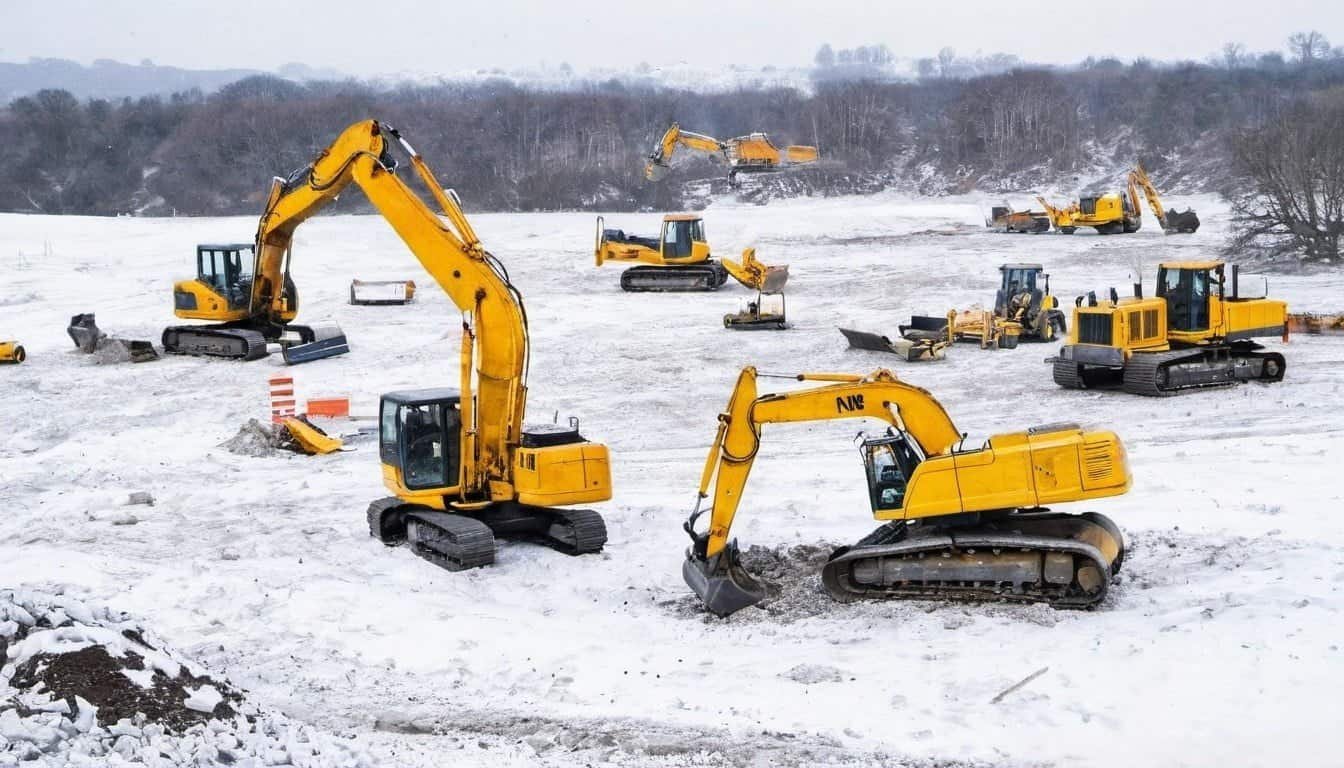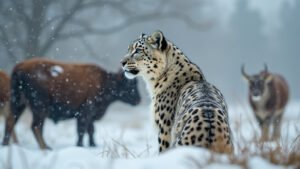Introduction
Human-wildlife conflict presents significant challenges for the conservation of snow leopards. These majestic animals, often referred to as “ghosts of the mountains,” are increasingly threatened by habitat loss, retaliatory killings, and competition for resources
In this article, we will explore the primary causes of these conflicts, their impacts on snow leopard populations, and the measures being taken to mitigate these issues. We will also discuss the economic implications for local communities and highlight successful conservation efforts aimed at fostering coexistence between humans and snow leopards
Habitat Loss Due to Human Activities
Human activities have led to significant habitat loss for snow leopards, which are native to the mountain ranges of Central and South Asia. This habitat degradation is primarily caused by expanding agricultural practices, infrastructure development, and mining operations
These activities not only reduce the amount of available habitat but also fragment it, making it difficult for snow leopards to find food, mates, and secure territories
Causes of Habitat Loss
The primary drivers of habitat loss for snow leopards include:
Agricultural Expansion: As human populations grow, there is an increasing demand for agricultural land. Farmers often clear mountain slopes and valleys to plant crops, reducing the snow leopards’ natural habitat. In countries like Nepal and Bhutan, the conversion of forested areas into agricultural land has been a significant issue
Infrastructure Development: The construction of roads, railways, and other infrastructure projects in mountainous regions disrupts snow leopard habitats. These developments lead to habitat fragmentation, making it harder for snow leopards to roam freely and access different parts of their territory. In China, the rapid development of transportation networks has been particularly impactful
Mining Operations: Mining activities in snow leopard habitats lead to significant ecological disruption. The extraction of minerals often involves blasting and other intrusive methods that destroy large swathes of habitat. In Mongolia, for example, mining for gold and other minerals has posed a severe threat to snow leopard populations
Effects on Snow Leopard Populations
The loss of habitat has several detrimental effects on snow leopard populations:
Reduced Prey Availability: Habitat loss leads to a decline in prey species such as ibex, blue sheep, and other mountain ungulates. With fewer prey available, snow leopards are forced to venture closer to human settlements in search of food, increasing the likelihood of conflict
Increased Human Encounters: As snow leopards’ natural habitats shrink, their encounters with humans become more frequent. These encounters often result in retaliatory killings when snow leopards prey on livestock, which further reduces their already dwindling numbers
Genetic Isolation: Habitat fragmentation isolates snow leopard populations, leading to reduced genetic diversity. This genetic isolation makes it harder for populations to adapt to changing environmental conditions and increases the risk of inbreeding
Mitigation Strategies
Efforts to mitigate the impact of habitat loss on snow leopards involve a combination of conservation initiatives, community engagement, and policy changes:
Protected Areas and Corridors: Establishing protected areas and wildlife corridors can help preserve critical habitats and ensure connectivity between different snow leopard populations. For example, the establishment of the Wakhan Corridor in Afghanistan has been crucial for maintaining genetic flow between populations
Sustainable Land-Use Practices: Promoting sustainable agricultural and land-use practices can help reduce habitat loss. Initiatives such as agroforestry and community-based natural resource management encourage local communities to adopt practices that are both environmentally friendly and economically beneficial
Restoration Projects: Habitat restoration projects aim to rehabilitate degraded areas and re-establish vegetation and prey species. In India, reforestation efforts in the Himalayas have shown promise in restoring habitats for snow leopards and other wildlife
Main Causes of Human-Wildlife Conflict
Human-wildlife conflict arises when the needs and behavior of wildlife impact negatively on human activities or vice versa, leading to harmful consequences for both parties. In the case of snow leopards, several factors contribute to these conflicts, which can result in detrimental outcomes for both the leopards and local communities
Livestock Predation
One of the most significant causes of conflict between humans and snow leopards is livestock predation. Snow leopards often prey on domestic animals such as sheep, goats, and yaks, especially in areas where their natural prey is scarce
This predation results in substantial economic losses for herders, who depend on their livestock for their livelihood:
Scarcity of Natural Prey: Habitat degradation and hunting reduce the availability of natural prey for snow leopards, forcing them to turn to livestock as an alternative food source. Studies have shown that in some regions, domestic animals can constitute up to 58% of a snow leopard’s diet
Easy Targets: Livestock, often less vigilant and more abundant than wild prey, become easy targets for snow leopards. In poorly guarded pastures, snow leopards can inflict significant damage in a short period, leading to the loss of multiple animals
Economic Impact: For many herding communities, the loss of even a few animals can have severe financial repercussions. This economic strain often leads to negative attitudes toward snow leopards and retaliatory killings as a means of protecting livestock
Human Encroachment
The encroachment of human activities into snow leopard habitats intensifies the potential for conflict. This encroachment includes:
Settlement Expansion: As human populations grow, settlements expand into previously uninhabited areas, encroaching on snow leopard territories. This expansion not only reduces available habitat but also increases direct encounters between humans and snow leopards
Resource Competition: Humans and snow leopards often compete for the same resources, such as water and grazing land. This competition can lead to overgrazing by livestock, further diminishing the natural prey base for snow leopards and exacerbating predation on domestic animals
Infrastructure Development: Roads, mining, and other infrastructure projects fragment snow leopard habitats, making it harder for them to find food and mates, and increasing the likelihood of human-wildlife interactions
Resource Competition
Resource competition between humans and snow leopards also plays a crucial role in escalating conflicts. This competition is evident in several ways:
Grazing Pressure: Livestock often graze in areas that overlap with snow leopard habitats, leading to overgrazing and depletion of vegetation. This reduces the availability of food for herbivorous prey species, indirectly affecting snow leopards
Water Resources: In arid and semi-arid regions, both humans and wildlife compete for limited water resources. The diversion of water for agricultural and domestic use can lead to habitat degradation, impacting snow leopards and their prey
Poaching: Poaching of prey species, such as ibex and blue sheep, reduces the natural food sources available to snow leopards. Additionally, snow leopards themselves are sometimes poached for their fur and bones, further reducing their populations
Retaliatory Killings and Their Impact
Retaliatory killings, also known as retributive killings, occur when humans kill snow leopards in response to livestock predation or other perceived threats. This practice poses a severe threat to snow leopard populations and exacerbates the ongoing conflict between humans and wildlife
Reasons for Retaliatory Killings
Retaliatory killings of snow leopards are primarily driven by the following factors:
Livestock Loss: When snow leopards prey on livestock, herders often suffer significant economic losses. Livestock is a primary source of income and sustenance for many rural communities, and the loss of even a few animals can be devastating. Consequently, herders may kill snow leopards in an attempt to protect their remaining livestock and prevent future losses
Lack of Compensation: In many regions, there are inadequate or non-existent compensation programs for livestock losses caused by snow leopards. Without financial support to offset their losses, herders may resort to killing snow leopards out of frustration and economic necessity
Cultural Factors: In some cultures, there is a long-standing tradition of retaliatory killings as a means of dealing with predators. These cultural attitudes can be deeply ingrained, making it challenging to change perceptions and practices even with the introduction of conservation initiatives
Impact on Snow Leopard Numbers
The impact of retaliatory killings on snow leopard populations is profound and multifaceted:
Population Decline: Retaliatory killings directly reduce the number of snow leopards in the wild. Given that snow leopards are already listed as vulnerable, any additional mortality can have significant implications for their survival. Studies estimate that up to 55% of snow leopard deaths are due to retaliatory killings
Disruption of Social Structure: The death of individual snow leopards can disrupt their social structure and breeding patterns. This disruption can lead to decreased reproductive success and lower cub survival rates, further compounding the decline in population numbers
Genetic Diversity Loss: Retaliatory killings can reduce genetic diversity within snow leopard populations. This loss of genetic diversity makes populations more susceptible to diseases and reduces their ability to adapt to environmental changes
Preventative Measures
Efforts to reduce retaliatory killings focus on preventative measures and community-based strategies that address the root causes of conflict:
Livestock Protection: Implementing better livestock protection measures, such as predator-proof corrals and night enclosures, can significantly reduce losses. The use of guard dogs and herding practices that keep livestock close to human settlements can also deter snow leopards from attacking
Compensation Programs: Establishing and maintaining fair and timely compensation programs for livestock losses can alleviate the financial burden on herders. These programs need to be accessible and adequately funded to ensure that affected individuals receive prompt compensation
Community Engagement: Engaging local communities in conservation efforts is crucial for changing attitudes towards snow leopards. Education and awareness campaigns that highlight the ecological importance of snow leopards and the benefits of coexistence can help shift perceptions and reduce retaliatory killings
Alternative Livelihoods: Providing alternative sources of income for herders, such as eco-tourism, handicrafts, and sustainable agriculture, can reduce their dependency on livestock and mitigate the economic impact of predation. Programs that promote these alternatives can improve local livelihoods and foster a more positive attitude towards snow leopard conservation
Conservation Measures to Mitigate Conflict
Effective conservation measures are crucial for mitigating human-wildlife conflict involving snow leopards. These measures focus on promoting coexistence, protecting snow leopard habitats, and ensuring the well-being of local communities
Various stakeholders, including governments, non-governmental organizations (NGOs), and local communities, play vital roles in these efforts
Community-Based Conservation Programs
Community-based conservation programs are integral to reducing conflict and fostering positive attitudes toward snow leopard conservation. These programs actively involve local communities in conservation activities and decision-making processes:
Snow Leopard Enterprises: Initiatives like Snow Leopard Enterprises (SLE) encourage herders to engage in alternative income-generating activities, such as producing and selling handicrafts. In exchange, herders commit to protecting snow leopards and their habitats. This approach not only provides financial benefits but also reduces the incentive for retaliatory killings
Livestock Insurance Programs: Community-based livestock insurance schemes provide compensation for livestock losses due to snow leopard predation. By paying a small premium, herders can receive compensation when their animals are killed, reducing the financial impact of such losses. Programs like these have been implemented successfully in Mongolia and Nepal
Community Patrols and Guardians: Training and employing local people as wildlife guardians or patrols helps monitor snow leopard populations and prevent illegal activities such as poaching. These guardians also work to mitigate conflict by implementing livestock protection measures and educating communities about snow leopard conservation
Government and NGO Initiatives
Governments and NGOs play essential roles in implementing conservation policies and programs that address human-wildlife conflict. These initiatives often involve scientific research, policy development, and direct intervention:
Snow Leopard Trust: The Snow Leopard Trust works across several countries to conduct research, implement conservation programs, and raise awareness about snow leopard conservation. Their initiatives include habitat protection, anti-poaching measures, and community engagement projects
Global Snow Leopard and Ecosystem Protection Program (GSLEP): This multi-national initiative aims to secure 20 snow leopard landscapes by 2020 through collaborative efforts among snow leopard range countries. The program focuses on habitat protection, reducing human-wildlife conflict, and fostering sustainable development in local communities
Government Policies and Legislation: National governments enact policies and legislation to protect snow leopards and their habitats. These policies include establishing protected areas, enforcing anti-poaching laws, and developing compensation programs for livestock losses. Effective implementation and enforcement of these policies are crucial for their success
Success Stories and Challenges
There have been notable successes in snow leopard conservation, but challenges remain. Understanding these successes and challenges can help improve future conservation efforts
Success Stories
Ladakh, India: The establishment of the Hemis National Park and the implementation of community-based conservation programs have led to a significant increase in snow leopard numbers and a reduction in human-wildlife conflict
Mongolia: The Tost Mountains were designated as a State Protected Area in 2016, largely due to the efforts of the Snow Leopard Trust and local communities. This designation has helped protect critical snow leopard habitats from mining and other threats
Challenges
Funding and Resources: Many conservation programs face challenges related to inadequate funding and resources. Sustaining long-term conservation efforts requires consistent financial support and investment
Community Involvement: Ensuring genuine and sustained community involvement can be challenging. Conservation programs must be designed to meet the needs and priorities of local communities while promoting snow leopard conservation
Climate Change: Climate change poses a significant threat to snow leopards by altering their habitats and affecting prey availability. Conservation efforts must address the impacts of climate change to ensure the long-term survival of snow leopards
Economic Impacts on Local Communities
Human-wildlife conflict, particularly involving snow leopards, has significant economic repercussions for local communities
These impacts stem mainly from livestock predation, leading to financial losses and creating challenges for subsistence and economic stability. Addressing these economic impacts is crucial for fostering coexistence and promoting sustainable livelihoods
Financial Losses from Livestock Predation
Livestock predation by snow leopards imposes substantial financial burdens on herders and local communities. These losses can be particularly devastating in regions where livestock represents a primary source of income and livelihood:
Direct Losses: When snow leopards prey on livestock, herders suffer direct financial losses. The loss of even a few animals can significantly impact household income, especially in rural areas where alternative income sources are limited. Studies have shown that livestock losses can account for a significant portion of a herder’s annual income
Indirect Costs: In addition to direct losses, herders may incur indirect costs, such as the need to invest in additional livestock protection measures. These measures, which can include building predator-proof enclosures and hiring additional herders, can be expensive and time-consuming
Emotional and Cultural Impact: Livestock often holds cultural and emotional significance for herding communities. The loss of livestock can lead to emotional distress and affect cultural practices and traditions, further emphasizing the need for effective conflict mitigation strategies
Compensation Programs
Compensation programs play a vital role in mitigating the economic impacts of livestock predation. These programs aim to provide financial relief to herders who suffer losses due to snow leopards, helping to reduce negative attitudes toward the predators and prevent retaliatory killings:
Government Compensation Schemes: Several countries with snow leopard populations have implemented government-funded compensation schemes. These programs compensate herders for livestock losses, reducing the economic burden and fostering a more positive attitude toward snow leopard conservation
NGO-Led Compensation Programs: Non-governmental organizations often play a crucial role in establishing and managing compensation programs. Organizations such as the Snow Leopard Trust have developed community-based compensation schemes that involve local stakeholders in the process, ensuring transparency and fairness
Challenges and Solutions: Effective compensation programs must overcome several challenges, including timely payments, accurate verification of livestock losses, and sustainable funding. Ensuring that compensation reaches affected herders promptly and fairly is essential for the success of these programs
Sustainable Livelihood Alternatives
Promoting sustainable livelihood alternatives is another critical strategy for mitigating the economic impacts of human-wildlife conflict. By diversifying income sources, communities can reduce their reliance on livestock and improve their economic resilience:
Eco-Tourism: Eco-tourism initiatives provide communities with alternative income opportunities while promoting snow leopard conservation. Guided wildlife tours, homestays, and cultural experiences can attract tourists and generate revenue for local communities. Successful eco-tourism projects in regions like Ladakh, India, have demonstrated the potential for snow leopard conservation to benefit local economies
Handicrafts and Artisanal Products: Encouraging the production and sale of handicrafts and artisanal products can provide additional income for herders. Programs that train community members in crafting and marketing traditional goods help preserve cultural heritage while offering economic benefits
Sustainable Agriculture: Implementing sustainable agricultural practices can improve food security and provide alternative income sources. Agroforestry, organic farming, and other sustainable practices can enhance the resilience of local communities and reduce the need for extensive livestock herding
Conclusion
Human-wildlife conflict, particularly involving snow leopards, presents significant challenges for both conservation efforts and local communities
Habitat loss due to human activities, such as agricultural expansion, infrastructure development, and mining, severely impacts snow leopard populations by reducing their prey availability and increasing encounters with humans. Retaliatory killings further exacerbate this problem, leading to a decline in snow leopard numbers and disrupting their social structures
Addressing these conflicts requires a multifaceted approach. Conservation measures, including community-based programs and initiatives by governments and NGOs, play a crucial role in mitigating conflict and promoting coexistence
Effective strategies, such as livestock protection, compensation programs, and sustainable livelihood alternatives, help reduce the economic burden on local communities and foster positive attitudes toward snow leopard conservation
Ultimately, the successful mitigation of human-wildlife conflict and the conservation of snow leopards depend on the active involvement and cooperation of all stakeholders, from local communities to international organizations
By promoting sustainable practices and ensuring that the benefits of conservation are shared equitably, we can create a future where snow leopards and humans coexist harmoniously in the mountainous regions of Central and South Asia











